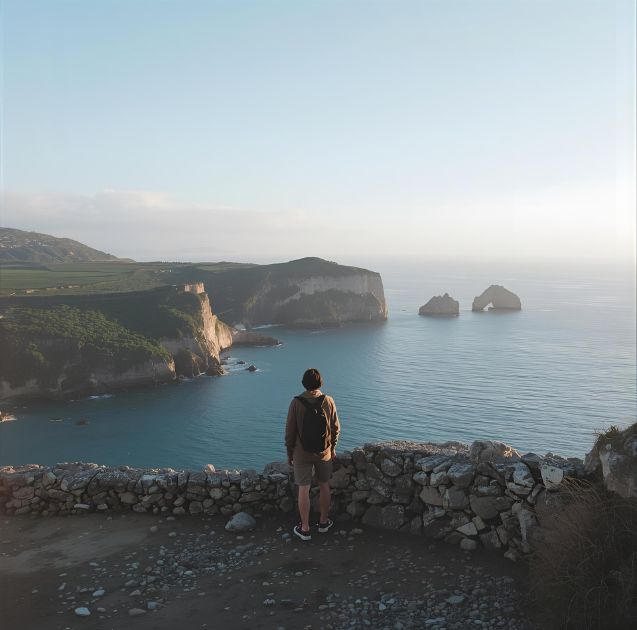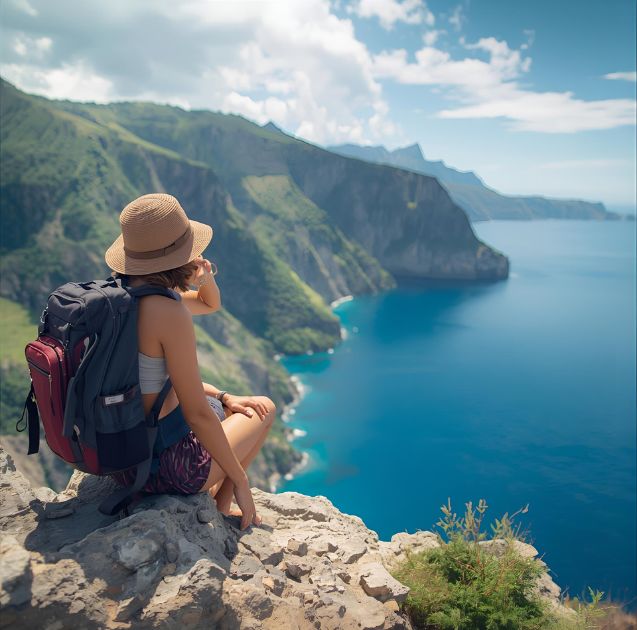
The idea of traveling the world solo is a potent cocktail of exhilarating freedom and heart-pounding fear. It’s a picture painted with images of self-discovery against stunning backdrops, of quiet moments of reflection in bustling cafes, and of forging your own path, one step at a time. Yet, for every daydream of independence, a wave of “what ifs” can rush in. What if I get lonely? What if it’s not safe? What if I don’t know what I’m doing?
If you’re standing on the precipice of your first solo adventure, know this: every seasoned solo traveler once stood exactly where you are now. The journey from dreaming to doing is paved with planning, preparation, and a healthy dose of courage. This guide is your roadmap. We’ll dismantle the anxieties, answer the pressing questions, and provide you with a comprehensive toolkit to transform your solo travel dream into an unforgettable reality. Get ready to embrace the unknown.
Why Travel Solo? The Unmatched Benefits of Going It Alone

Before we dive into the nuts and bolts, let’s talk about the “why.” Traveling with friends or family is wonderful, but solo travel offers a unique set of rewards that can be truly life-altering. It’s more than just a vacation; it’s an investment in yourself.
- Ultimate Freedom and Flexibility: Your itinerary is entirely your own. Want to spend an entire day in one museum? Go for it. Feel like scrapping your plans to follow a local’s recommendation for a hidden beach? You can. There are no compromises, no scheduling conflicts, and no need to cater to anyone else’s interests. Every single decision is yours.
- Profound Self-Discovery: When you’re alone in an unfamiliar place, you learn to rely on yourself in a way you never have to at home. You’ll navigate challenges, solve problems, and become your own best company. This process strips away the noise of daily life and reveals a stronger, more resilient, and more resourceful version of you.
- Boosted Confidence and Independence: Successfully navigating a foreign country, ordering a meal in a different language, or simply enjoying your own company for dinner is incredibly empowering. Each small victory builds a foundation of unshakeable confidence that you’ll carry back home with you.
- Deeper Cultural Immersion: Traveling solo makes you more approachable. Locals are often more inclined to strike up a conversation with a single traveler, and you’re more likely to step out of your comfort zone and engage. You observe more, listen more intently, and experience your destination on a much deeper level.
Choosing Your First Solo Destination: Key Considerations
The world is vast, and picking that first destination can feel overwhelming. The perfect spot for a first-timer is a place that aligns with your interests while offering a comfortable level of challenge. Here’s how to narrow it down:
1. Safety First, Always
Your primary concern should be safety. Look for countries with low crime rates, stable political climates, and a reputation for being welcoming to tourists. Resources like the U.S. Department of State’s travel advisories or the Global Peace Index are excellent starting points. Read blogs and forums for on-the-ground experiences from other solo travelers, particularly solo female travelers, who often provide invaluable safety insights.
2. The Tourist Trail is Your Friend
For your first trip, there’s no shame in sticking to the beaten path. Destinations with a well-established tourist infrastructure (e.g., plenty of hostels, tour options, and English-speaking locals) can significantly ease the logistical and mental burden. It’s much easier to build confidence when you’re not struggling with basic navigation and communication.
3. Budget Accordingly
Be realistic about your finances. Southeast Asia and parts of Eastern Europe are famously budget-friendly, allowing your money to go further. Western Europe, North America, and Australia will require a more substantial budget. Calculate a rough daily cost for accommodation, food, and activities to see what’s feasible.
4. Consider Your Interests
What do you want to get out of this trip? Are you craving bustling cities with world-class art? Serene landscapes for hiking and reflection? Sandy beaches for relaxation? A vibrant social scene? Matching the destination to your passions ensures you’ll be genuinely engaged and excited.
Top Destinations for First-Time Solo Travelers:

- Portugal: Safe, affordable, and incredibly beautiful. With friendly locals, delicious food, and a fantastic hostel network in cities like Lisbon and Porto, it’s a perfect European starting point.
- New Zealand: An adventure-lover’s paradise. It’s exceptionally safe, English is the primary language, and the infrastructure for backpackers and solo travelers is second to none.
- Thailand: The quintessential backpacker hub for a reason. It’s incredibly affordable, easy to get around, and has a built-in social scene that makes meeting other travelers effortless.
- Costa Rica: Known for its “Pura Vida” lifestyle, it offers a great mix of eco-tourism, adventure, and relaxation. It’s considered very safe for Central America and has a solid tourist trail.
- Iceland: Consistently ranked as one of the safest countries in the world. While it’s on the pricier side, its otherworldly landscapes are easily explored through organized tours, making it a stress-free option for first-timers.
Planning and Preparation: Your Pre-Trip Checklist
Spontaneity is a joy of travel, but a solid foundation of planning is what makes that spontaneity possible. A well-prepared trip is a stress-free trip.
Crafting Your Budget
Break down your expenses into pre-trip costs and on-the-road costs. This will prevent any nasty financial surprises.
- Major Costs: Flights and travel insurance are your biggest upfront expenses. Book flights 2-3 months in advance for better prices. Do not skip travel insurance. It’s a non-negotiable safety net.
- Accommodation: Research average hostel or budget hotel prices in your destination. Book at least your first few nights in advance to have a place to land.
- Daily Spending: Estimate costs for food, local transport, entrance fees, and activities. It’s always wise to overestimate this slightly.
- Emergency Fund: Have a separate stash of money (or a credit card) reserved strictly for emergencies, like a missed flight or a medical issue.
Essential Documents & Health
Get your paperwork in order well before you leave.
- Passport and Visas: Check that your passport is valid for at least six months beyond your planned return date. Research visa requirements for your destination country.
- Digital and Physical Copies: Make photocopies of your passport, visa, driver’s license, and credit cards. Keep one set with you (separate from the originals) and leave another set with someone at home. Also, save digital copies in a secure cloud service like Google Drive or Dropbox.
- Health Check: Visit your doctor or a travel clinic 4-6 weeks before your trip to get any necessary vaccinations and medications.
The Art of Packing Light
Lugging a heavy suitcase is the enemy of happy solo travel. Packing light gives you mobility and freedom. Embrace minimalism.
- Choose the Right Bag: A comfortable travel backpack (40-50 liters is a good size) is often more practical than a rolling suitcase, especially if you’ll be navigating cobblestone streets or hopping on and off trains.
- Packing Cubes are Magic: These organizational wonders compress your clothes and keep your bag tidy.
- The Rule of Three: Pack clothes in versatile, neutral colors that can be layered and mixed. For a week-long trip, you might pack three pairs of pants, three tops, etc., and plan to do laundry.
- Essentials Only: Include a basic first-aid kit, a portable power bank, a universal travel adapter, and any prescription medications. Remember, you can buy most toiletries at your destination.
Staying Safe and Smart on the Road
Safety is less about avoiding danger and more about being smart, aware, and prepared. A little bit of vigilance goes a long way in ensuring a smooth trip.
- Situational Awareness: Be present and aware of your surroundings. Avoid walking with headphones in at night, and keep your phone and valuables out of sight in crowded areas.
- Trust Your Gut: Your intuition is your best safety tool. If a person, place, or situation feels off, it probably is. Remove yourself from it without hesitation.
- Inform Someone: Share your itinerary with a friend or family member back home and check in with them regularly.
- Blend In: Observe how locals dress and act. The less you look like a tourist, the less of a target you become for scams or petty theft.
- Secure Your Valuables: Use locks on your bags, especially in hostels. Don’t carry all your cash and cards in one place. Consider an anti-theft bag or a money belt for extra peace of mind.
- Be Smart About Alcohol: Enjoy a drink, but know your limits. Never leave your drink unattended, and be wary of accepting drinks from strangers.
Making Connections (Without the Pressure)
One of the biggest fears for first-timers is loneliness. The good news is that solo travel doesn’t have to mean being alone 24/7. It’s incredibly easy to meet people if you want to.
- Stay in Hostels: The single best way to meet other travelers. The common areas are designed for social interaction. Join in on a hostel-organized pub crawl or walking tour.
- Take a Group Tour: A day trip, a cooking class, or a free walking tour is a fantastic way to spend a few hours with like-minded people.
- Use Technology: Apps like Meetup or Bumble BFF can connect you with locals or other travelers. Facebook groups for backpackers in specific countries are also great resources.
- Just Be Open: Smile. Sit at the bar instead of a table. Ask someone for directions. A simple, open demeanor is often all it takes to start a conversation.
And remember, it’s also perfectly okay to want to be alone! Cherish the quiet moments. Read a book in a park. Savor a meal by yourself. It’s your trip.
Conclusion: Your Adventure Awaits
The first solo trip is a rite of passage. It will challenge you, change you, and leave you with a treasure trove of stories and a newfound sense of capability. The fear you might be feeling now is just the shadow cast by an enormous, exciting opportunity for growth. By planning thoughtfully, packing smartly, and staying aware, you are more than capable of navigating the world on your own terms.
So, take a deep breath. Do the research. Book the ticket. The world is far less intimidating and far more wonderful than you can imagine. Your definitive solo adventure is not just a dream—it’s waiting for you to take the first step.
Want to explore the world while minimizing your impact? The Conscious Traveler & Compass: A Comprehensive Guide to Sustainable and Ethical Journeys provides practical tips and insights for making your adventures more responsible and meaningful.




Leave a Reply